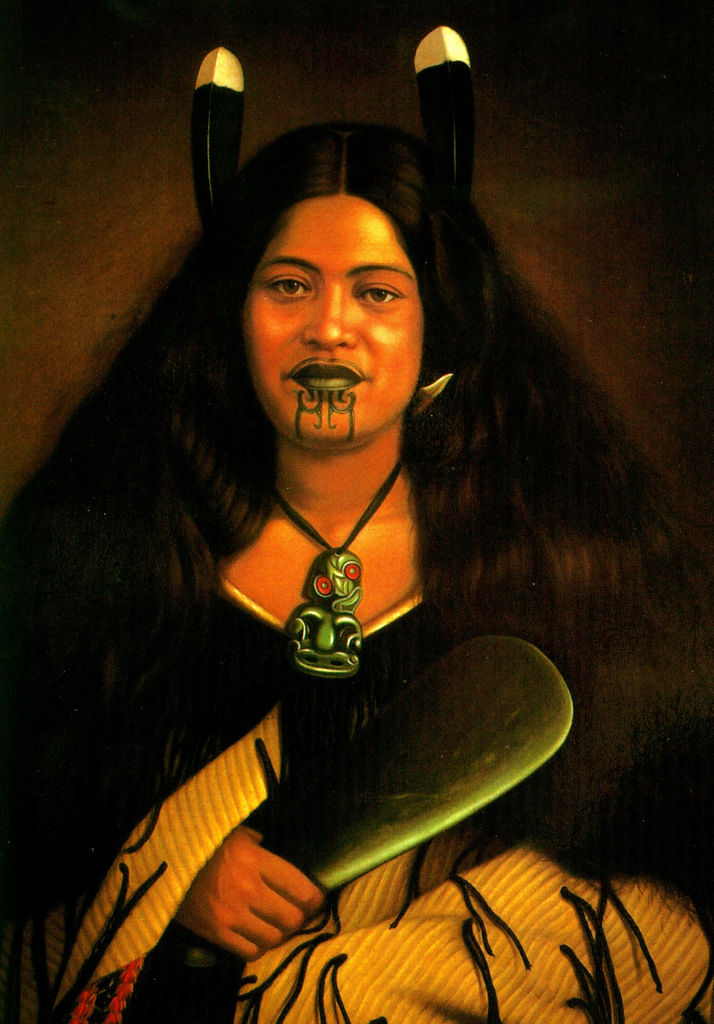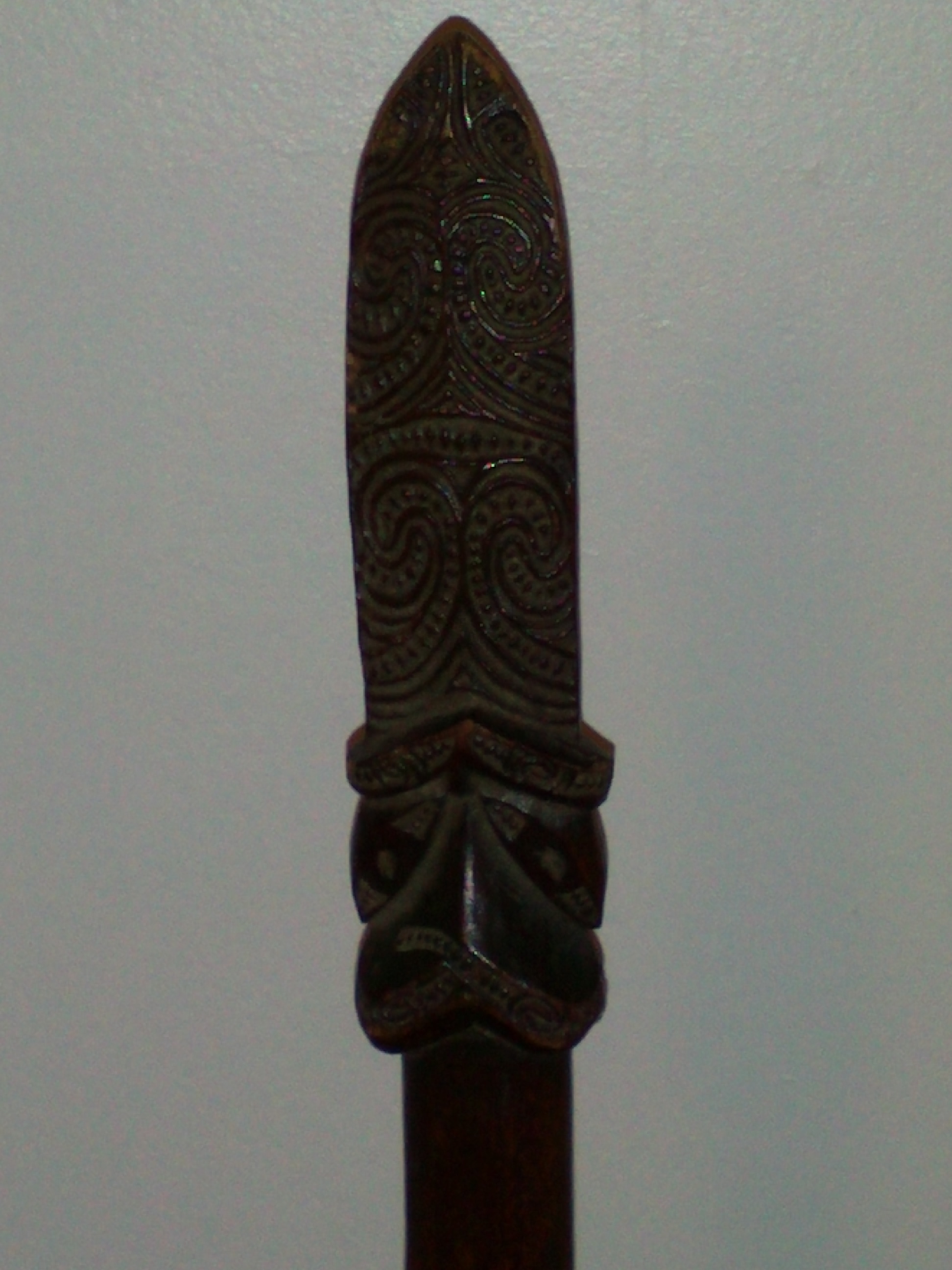|
Tewhatewha
A tewhatewha is a long-handled Māori club weapon shaped like an axe. Designed to be held in two hands, the weapon comes to a mata (point) at one end and a rapa (broad, quarter-round head) at the other. Use Like pouwhenua and taiaha, this long club was designed for sparring and lightning strokes and thrusts, aided by quick footwork on the part of the wielder. The blows were not struck with the blade as one would with an axe, but rather with the thicker straight front edge. It was common for tewhatewha to be decorated with a bunch of split pigeon or hawk feathers which hang from a drilled hole near the lower edge of the extension. This decoration may have also had the added benefit of confusing an opponent Modern use A tewhatewha was the symbol of command of Royal New Zealand Navy hydrographic survey ship HMNZS ''Resolution''. The drum major of the New Zealand Army Band uses a tewhatewha instead of a mace to give direction and keep time. See also * Mau rākau Other Māori w ... [...More Info...] [...Related Items...] OR: [Wikipedia] [Google] [Baidu] |
Mere (weapon)
The mere () is a type of short, broad-bladed weapon in the shape of an enlarged tear drop. It was used to strike/jab an opponent in the body or the head, usually made from nephrite jade (pounamu or greenstone). A mere is one of the traditional, hand to hand, one-handed weapons of the indigenous Māori of New Zealand, and a symbol of chieftainship. Form The mere is a spatulate, leaf shaped, form of short club. It has a broad, rounded apex that narrows to form a handle, terminating in a butt or heel (reke), marked by several grooves. Mere have two convex, almost flat sides and a rounded top. The top of the mere was ground to a sharp edge, extending down both sides of the weapon. Generally, short clubs had holes carved or drilled through the butt end of the handle, allowing a wrist cord (tau or patui) made of plaited New Zealand flax, or Polynesian dog skin, to be passed through and attached to the wielder's wrist. Passing the wrist cord over the thumb and around the hand p ... [...More Info...] [...Related Items...] OR: [Wikipedia] [Google] [Baidu] |
Pouwhenua
Pouwhenua or pou whenua (land post), are carved wooden posts used by Māori, the indigenous peoples of New Zealand to mark territorial boundaries or places of significance. They are generally artistically and elaborately carved and can be found throughout New Zealand. The Pouwhenua is also a long-handled fighting staff with a club-like broad head for striking. Cultural significance Much like totem poles, pou whenua tell a story. They are significant to the Māori people, representing their contributions to the cultural heritage of New Zealand. They acknowledge the association between the people ( tāngata) and the land (whenua). Specifically, they reflect the relationship between the ancestors, environment, and the reputation or standing of the tangata whenua. Weaponry Belonging to the same class of weaponry as the tewhatewha and taiaha, pouwhenua are usually made of wood and have a large, broad blade known as ''rau'' at one end and a pointed, sharp tip at the other end. Usua ... [...More Info...] [...Related Items...] OR: [Wikipedia] [Google] [Baidu] |
Taiaha
A taiaha () is a traditional weapon of the Māori of New Zealand; a close-quarters staff weapon made from either wood or whalebone, and used for short, sharp strikes or stabbing thrusts with efficient footwork on the part of the wielder. Taiaha are usually between in length. It has three main parts; the ''arero'' (tongue), used for stabbing the opponent and parrying; the ''upoko'' (head), the base from which the tongue protrudes; and the ''ate'' (liver) or ''tinana'' (body), the long flat blade which is also used for striking and parrying. Use Mau rākau is the martial art that teaches the use of the taiaha and other Māori weapons in combat. As with other martial arts styles, students of the taiaha spend years mastering the skills of timing, balance and co-ordination necessary to wield the weapon effectively. The taiaha is widely known due to its use in the ''wero'' — the traditional Māori challenge during the pōwhiri, a formal welcoming ceremony. A ''wero'' is commo ... [...More Info...] [...Related Items...] OR: [Wikipedia] [Google] [Baidu] |
Pouwhenua
Pouwhenua or pou whenua (land post), are carved wooden posts used by Māori, the indigenous peoples of New Zealand to mark territorial boundaries or places of significance. They are generally artistically and elaborately carved and can be found throughout New Zealand. The Pouwhenua is also a long-handled fighting staff with a club-like broad head for striking. Cultural significance Much like totem poles, pou whenua tell a story. They are significant to the Māori people, representing their contributions to the cultural heritage of New Zealand. They acknowledge the association between the people ( tāngata) and the land (whenua). Specifically, they reflect the relationship between the ancestors, environment, and the reputation or standing of the tangata whenua. Weaponry Belonging to the same class of weaponry as the tewhatewha and taiaha, pouwhenua are usually made of wood and have a large, broad blade known as ''rau'' at one end and a pointed, sharp tip at the other end. Usua ... [...More Info...] [...Related Items...] OR: [Wikipedia] [Google] [Baidu] |
Patu
A patu is a club or pounder used by the Māori. The word ''patu'' in the Māori language means to strike, hit, beat, kill or subdue. Weapons These types of short-handled clubs were mainly used as a striking weapon. The blow administered with this weapon was a horizontal thrust straight from the shoulder at the enemy's temple. If the foe could be grasped by the hair then the patu would be driven up under the ribs or jaw. Patu were made from hardwood, whale bone, or stone. The most prestigious material for the patu was pounamu (greenstone). Maori decorated the patu by carving into the wood, bone or stone. Types of patu include: * ''patu pounamu'' or ''mere'': made from pounamu (greenstone). * ''patu onewa'': made of stone. These resemble the mere in outline but thicker, because the stone used was more easily broken than the resilient pounamu. * ''patu paraoa'': made of whale bone * ''patu tawaka'' and ''patuki'': made from wood. Other styles of short handled wooden clubs inclu ... [...More Info...] [...Related Items...] OR: [Wikipedia] [Google] [Baidu] |
Taiaha
A taiaha () is a traditional weapon of the Māori of New Zealand; a close-quarters staff weapon made from either wood or whalebone, and used for short, sharp strikes or stabbing thrusts with efficient footwork on the part of the wielder. Taiaha are usually between in length. It has three main parts; the ''arero'' (tongue), used for stabbing the opponent and parrying; the ''upoko'' (head), the base from which the tongue protrudes; and the ''ate'' (liver) or ''tinana'' (body), the long flat blade which is also used for striking and parrying. Use Mau rākau is the martial art that teaches the use of the taiaha and other Māori weapons in combat. As with other martial arts styles, students of the taiaha spend years mastering the skills of timing, balance and co-ordination necessary to wield the weapon effectively. The taiaha is widely known due to its use in the ''wero'' — the traditional Māori challenge during the pōwhiri, a formal welcoming ceremony. A ''wero'' is commo ... [...More Info...] [...Related Items...] OR: [Wikipedia] [Google] [Baidu] |
Kotiate
Kotiate is a type of traditional hand weapon of the Māori, the indigenous people of New Zealand. A kotiate is a short club normally made of wood or whalebone. Kotiate means to cut or divide the liver (koti = cut in two or divide; ate = liver), is probably taken from its shape, which resembles the lobed part of the human liver. See also *Mere (weapon) *Pouwhenua *Tewhatewha *Patu *Taiaha *Wahaika A Wahaika is a type of traditional Māori hand weapon. Wahaika are short club-like weapons usually made of wood or whalebone and are used for thrusting and striking in close-quarter, hand-to-hand fighting. Whalebone wahaika are called ''wahaika ... References External linksKotiate in the collection of the Museum of New Zealand Te Papa Tongarewa">Museum of New Zealand Te Papa Tongarewa">Kotiate in the collection of the Museum of New Zealand Te Papa Tongarewa Clubs (weapon) Māori weapons Ceremonial weapons {{Blunt-weapon-stub ... [...More Info...] [...Related Items...] OR: [Wikipedia] [Google] [Baidu] |
Mau Rākau
Mau rākau, meaning "to bear a weapon", is a martial art based on traditional Māori weapons. Weapons Mau rākau is a general term referring to the skilled use of weapons. It is said that the use of weapons was taught in the Whare-tū-taua (House or school of war). The term Mau taiaha is used to refer to the use of the taiaha and does not necessarily include other weapons. Regular schools are held on Mokoia Island in Lake Rotorua to teach the use of the taiaha. Mita Mohi established the Mokoia taiaha wānanga, which had trained more than 11,000 people over more than 30 years, , and had reached more than 20,000 people by the time of his death in 2016. One of those is actor Cliff Curtis, who attended a Mau Rakau taiaha programme on Mokoia Island at the age of 10. Curtis was like a son to Mohi, and helped him out whenever he could at programmes in prisons and the community. Other Māori weapons: *Mere (weapon) *Kotiate *Tewhatewha *Patu *Pouwhenua *Wahaika Mythology It is said we ... [...More Info...] [...Related Items...] OR: [Wikipedia] [Google] [Baidu] |
Māori Weapons
Māori or Maori can refer to: Relating to the Māori people * Māori people of New Zealand, or members of that group * Māori language, the language of the Māori people of New Zealand * Māori culture * Cook Islanders, the Māori people of the Cook Islands * Cook Islands Māori, the language of the Cook Islanders Ships * SS Maori, SS ''Maori'', a steamship of the Shaw Savill Line, shipwrecked 1909 * , a Royal Navy Tribal-class destroyer, sunk in 1915 * , a Royal Navy Tribal-class destroyer, launched 1936 and sunk 1942 * TEV ''Maori III'', a Union Company, Union Steam Ship Company inter-island ferry, 1952–74 Sports teams * New Zealand Māori cricket team * New Zealand Māori rugby league team * New Zealand Māori rugby union team Other * ''Maori'', a novel by Alan Dean Foster *Mayotte, in the Bushi language {{disambiguation, ship Language and nationality disambiguation pages ... [...More Info...] [...Related Items...] OR: [Wikipedia] [Google] [Baidu] |
Clubs (weapon)
Club may refer to: Arts, entertainment, and media * ''Club'' (magazine) * Club, a ''Yie Ar Kung-Fu'' character * Clubs (suit), a suit of playing cards * Club music * "Club", by Kelsea Ballerini from the album ''kelsea'' Brands and enterprises * Club (cigarette), a Scottish brand of cigarettes * Club (German cigarette), a German brand of cigarettes * Club Med, a holiday company Food * Club (soft drink) * Club Crackers * Club sandwich * Club (biscuit), a brand of biscuits manufactured by Jacob's (Ireland) and McVitie's (UK) Objects * Club (weapon), a blunt-force weapon * Golf club * Indian club, an exercise device * Juggling club * Throwing club, an item of sport equipment used in the club throw * Throwing club, an alternative name for a throwing stick Organizations * Club (organization), a type of association * Book discussion club, also called a book club or reading circle * Book sales club, a marketing mechanism * Cabaret club * Gentlemen's club (traditional) * Health club ... [...More Info...] [...Related Items...] OR: [Wikipedia] [Google] [Baidu] |
Ceremonial Weapons
A ceremonial weapon is an object used for ceremony, ceremonial purposes to display power or authority. They are often used in parades and as part of dress uniforms. Although they are descended from weapons used in actual combat, they are not normally used as such. Their form and, especially, their finishing and decoration are typically designed to show status and power and to be an impressive sight, rather than for practicality as a weapon. Quite often, ceremonial weapons are constructed with precious metals or other materials that make them too delicate for combat use. With ceremonial swords, an example of this is that the sword may be poorly balanced. Historically, however, many ceremonial weapons were also capable of actual combat, most notably in the military. Ceremonial mace, Maces, halberds, daggers and swords are the most common form of ceremonial weapons, but in theory almost any weapon can become ceremonial. The Sergeant at Arms in some parliaments carries a ceremonial ... [...More Info...] [...Related Items...] OR: [Wikipedia] [Google] [Baidu] |







